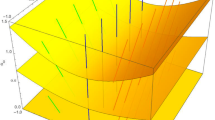Abstract
The prediction of general relativity on the gravitational collapse of matter ending in a point is viewed as an absurdity of the kind to be expected in any consistent physical theory due to ultimate conflicts of the axioms of geometry with the properties of physical objects. The necessity to introduce a probability interpretation for the solution of partial differential equations in space time for quantum theory points to similar roots. It is pointed out that quantum theory in the very small is not going to eliminate the problem, but macroscopic quantum effects in the large, modifying the properties of the horizon, may achieve it. Solutions such as wormholes allow as much empirical evidence as any science fiction. The present approach considers successive modifications of the field equations and equations of motion of gravitational theory by admixture of terms with higher derivatives. The rigorous application of a gauge principle combines Einstein's equations with the tensor analog of Maxwell's equations which are of third order for the metric. It is speculated that the natural presence of torsion in such a gauge theory is related to matter sources.
Similar content being viewed by others
References
A. Einstein and N. Rosen,Phys. Rev. 48, 73–77 (1935).
E. Schroedinger,Physica 6, 889–912 (1939);Proc. R. Irish Acad. A 46, 24–47 (1940).
B. DeWitt and R. Utiyama,J. Math. Phys. 3, 609 (1962).
L. Halpern,Arkiv Phys. 39 (43), 539 (1967); inRelativity and Gravitation (Birthday Volume for N. Rosen) (Gordon & Breach, New York, 1971), p. 159. R. Gable, Master's Thesis, University of Windsor, Canada, 1972.
L. Halpern, inSpinors, Twistors and Clifford Algebras, Z. Oziewiczet al., eds. (Kluwer, Dordrecht, 1993).
L. Halpern, to appear inInt. J. Theor. Phys. 33, 401 (1994).
N. Yang,Phys. Rev. Lett. 33, 445 (1974).
Author information
Authors and Affiliations
Rights and permissions
About this article
Cite this article
Halpern, L. Matter and geometry in a unified theory. Found Phys 24, 1697–1703 (1994). https://doi.org/10.1007/BF02054791
Received:
Issue Date:
DOI: https://doi.org/10.1007/BF02054791




